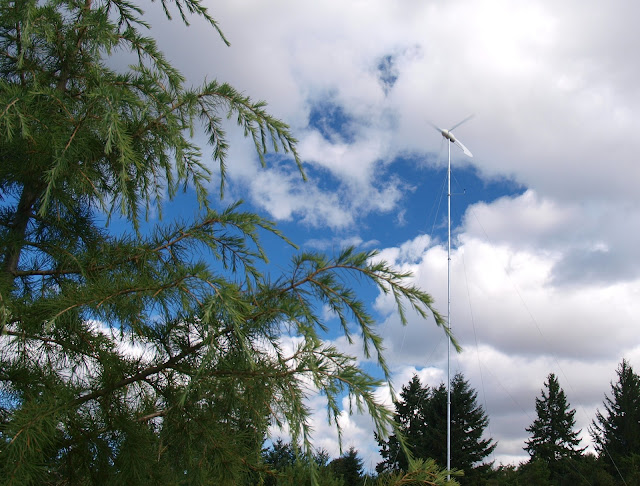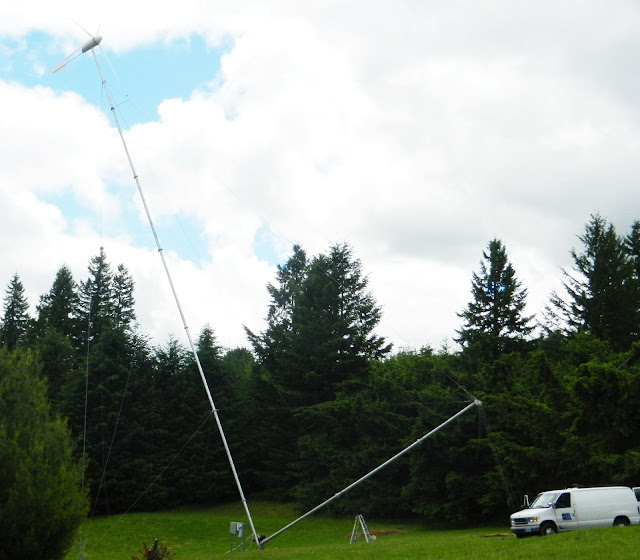Looking for the May NewFO linky party and giveaway? Click right here.
Our wind turbine has been shut down for the past couple of months because of a tiny, seemingly irrelevant part that decided to give up the ghost. The tiny anemometer, so tiny it is only barely visible in the image below, apparently is crucial to the proper operation of the wind turbine. Yes, that's it. Marked with a red arrow.
Because of a series of miscommunications (nobody's fault, really), the wind turbine has been shut down for several months. Finally yesterday, the same crew that erected the tower and turbine originally were able to come out to repair it. We have enjoyed working with these folks. The main man of the company, Steve, is a young guy who works very hard, and is trying to establish a business in alternative energy. Our tower is 120 feet tall, and while it looks small in the images above, the turbine is big. Much bigger than a grown man. Needless to say, it is a hazardous operation to lower the turbine for repairs. It requires two trucks, three men, and a cat.
There's the cat.
The tower is held aloft by three sets of guy wires.
They are about as thick as your index finger.
Here is the panel that holds all the works for generating power. The turbine isn't actually hooked to the power going into the house. Rather, it is hooked into the grid. When power is being generated, it is going back onto the grid. Then, when we are using electricity in the house, our power usage comes from the grid. There is a separate meter that is read by the power company each month. Depending on our usage in the house, if the turbine is generating electricity, sometimes our meter moves backwards. The meter in the image below is irrelevant to the power company, but it allows us to see how much power is being generated.
This is what it looks like inside the large gray box on the left.
And we're not just kidding around. We are a little power generation substation, and one must watch one's P's and Q's to avoid electrocution.
If an electrician comes to do work on our house, he or she must cut off power to the house, but also must cut off power being generated by the wind turbine. For that reason, there are signs posted at the main meter to remind workers that electricity is being generated from two different sources: the main grid, and the wind turbine.
On. Off. Any questions?
The blue box marked in the image below has nothing to do with anything at all. It's a wireless antenna. It transmits information from the meter to Mike's computer in the house so that he can see at any given second what the wind turbine is doing. And Mike's computer in the house also transmits the same information to Mike's iPhone. Yes, he's an engineer. If a thing can be monitored electronically, you can bet that we are scrutinizing its every move.
So here's how this job goes. The guy wires are anchored into the ground with concrete pilings, hooks, screws, and other assorted hardware. To raise and lower the tower for repairs and maintenance, it is necessary to have a device known as a gin pole that acts as a lever that workers pull against.
On the opposite side, a pulley system is rigged up that allows them to take the slack out of the opposing guy wire as the tower is lowered.
A rope is stretched to the far side for this purpose. This will make more sense below when you see it in operation.
Then a truck with a winch drives waaaaaaaaaaaaaaay over to the other side of the property. The truck will be used to slowly lower the tower once the rigging is all set up.
That cable is wrapped around one of the tree trunks on the perimeter of the property for even more leverage.
In the image below, you can see one of the three men who is assigned the task of taking up the slack in the opposing guy wire.
While they were doing their rigging, I amused myself by checking out things in the garden. You needed an interlude, didn't you?
It's been raining for a solid week, and amazingly, this iris still opened. I feared it would rot and I wouldn't get to see it. This is the one I was curious about. It was planted at the same time as all the others, but it has never bloomed before. It is slightly different in color from the other apricot ones that we have. Here's a close-up. They are such incredible flowers.
These are our Hood strawberries, getting close to ripening. Hopefully, the deer and squirrels will leave some for us this year.
And the first hydrangea is opening!
Okay, so here we go. When they untethered the gin pole from the concrete piling, the tower started to wobble menacingly. Even though I knew there was little danger of it collapsing, it still made me a little nauseous watching it. Then they started the slow process of lowering it.
Watch how, as the tower gets closer to the ground, the gin pole raises up until it is completely vertical.
The three men involved in the process communicated with radios. The truck backs up, moving closer to the tower and lowers it to the ground.
Lower
Lower
Lower
Almost there
As the turbine itself nearly reaches the ground, the take-up-the-slack man moves over to prevent the blades from hitting the ground.
When it is completely lowered, they use a sturdy ladder to support the pole. You can see how large the turbine itself is.
And there's that pesky broken anemometer. It's tiny compared to the size of the turbine.
They repaired the anemometer, performed annual maintenance, and also fixed a recall problem. Our turbine has a five year warranty, and so all of this work is performed for free for the first five years. After that, we will be on the hook to keep it repaired and maintained, and it requires annual maintenance. Each year, they will go through this same process to check for any problems and perform needed lubrication.
As I write this, the turbine is still down. The plan is for them to return tomorrow to raise it back up, and then we'll be back in business generating electricity.




































9 comments:
Fascinating. I've always wondered how they maintain the turbines and towers and now I know. Out of town more are appearing in the countryside but here in London you only see the small scale ones.
That is a very coordinated effort to repair the anemometer. It is good that Smitty was there to help!
Your iris is gorgeous! I haven't seen any of that color before.
Beautiful irises!
Wow, that's quite an operation for the wind turbine! Every year?
That is fascinating. Some people five or six miles from us recently put in a wind turbine, although theirs in erected on the kind of tower shown in the advertisement.--If one around here were like yours, it would spend most of its life on the ground since our winds are usually so high. A couple of years or so ago, the local electric co-op published quite a bit of information about possibility for private citizens on erecting wind towers--but they started at about $30 K.
Love that you are able to use one!
I am with everyone else in saying "Wow"! That is quite the deal and I, also, have wondered about such things. Living on a ridge in S.E. MN, we have often thought about such energy sources but the return would not offset the expenditure and we aren't in a position to just donate to be "green". Fascinating and beautiful irises! Hugs, D
Goodness, what an task for that little part but glad it is back to work, I know it all went smoothly with Smitty's expert supervision.
Lucky for Gracie, those mans worked on the OUTside of the house!
That was a very interesting operation. I haven't ever seen a "personal" wind turbine before. I think I'd like to be able to check the output from my computer too - guess I have a little 'engineer' in me too. :)
That is interesting. WE are sure Smitty was the biggest helper there!
Nan
The idea of wind turbines hasn't caught on in our state but WM and I saw several wind-farms during our trip through south-east Western Australia. Your post was most interesting and made even more so by our up-close-and-personal encounter with these graceful machines!
Post a Comment